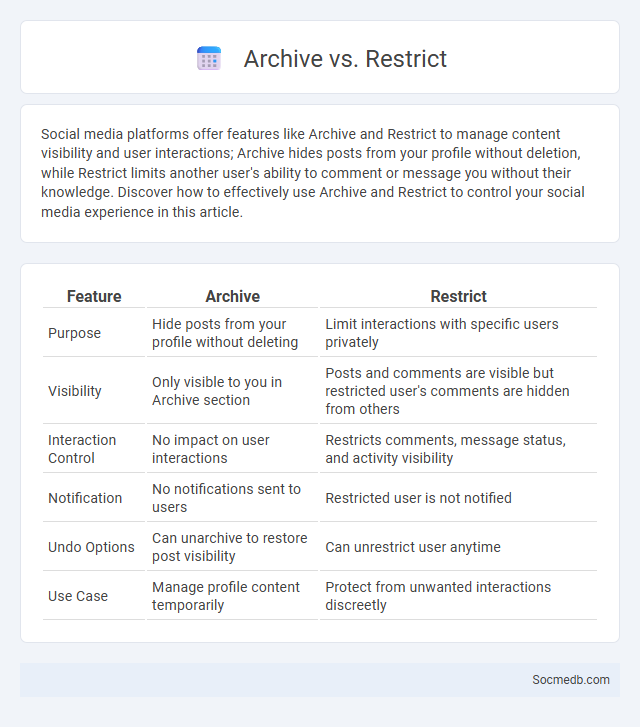
Photo illustration: Archive vs Restrict
Social media platforms offer features like Archive and Restrict to manage content visibility and user interactions; Archive hides posts from your profile without deletion, while Restrict limits another user's ability to comment or message you without their knowledge. Discover how to effectively use Archive and Restrict to control your social media experience in this article.
Table of Comparison
| Feature | Archive | Restrict |
|---|---|---|
| Purpose | Hide posts from your profile without deleting | Limit interactions with specific users privately |
| Visibility | Only visible to you in Archive section | Posts and comments are visible but restricted user's comments are hidden from others |
| Interaction Control | No impact on user interactions | Restricts comments, message status, and activity visibility |
| Notification | No notifications sent to users | Restricted user is not notified |
| Undo Options | Can unarchive to restore post visibility | Can unrestrict user anytime |
| Use Case | Manage profile content temporarily | Protect from unwanted interactions discreetly |
Understanding the Difference: Archive vs Restrict
Understanding the difference between archive and restrict on social media is essential for effective account management. Archiving hides posts from your profile without deleting them, preserving content for future reference or personal use. Restricting limits who can see your interactions and messages without blocking or unfollowing, providing a subtle way to manage privacy and control engagement.
What Does "Archive" Mean?
In social media, "Archive" refers to the feature that allows users to hide posts from their public profile without permanently deleting them. Archived content remains accessible only to the user, enabling discreet organization and retrieval later. This function enhances privacy control and post management across platforms like Instagram and Facebook.
Defining "Restrict" in Digital Contexts
In digital contexts, "restrict" refers to limiting interactions or visibility on social media platforms to enhance privacy and control. You can restrict accounts to prevent unwanted messages, comments, or content exposure without blocking or unfriending someone. This feature helps maintain a safer online environment by managing who can see your posts and engage with you.
When to Use Archive Instead of Restrict
Use the Archive feature on social media when you want to hide posts from your profile temporarily without deleting them, preserving your content and engagement data. Restrict is better suited for limiting specific users' interactions without alerting them, reducing negative comments or messages from appearing publicly. You can maintain a positive online environment by choosing Archive for content management and Restrict for managing interactions.
Benefits of Archiving Content
Archiving social media content preserves valuable brand history, ensuring access to past posts for long-term strategic planning and legal compliance. It enhances brand reputation management by allowing companies to review and analyze historical interactions and user feedback. Effective archiving supports data-driven marketing insights, improving future campaign targeting and audience engagement.
Advantages and Limitations of Restricting Access
Restricting access to social media platforms enhances your online privacy and reduces exposure to harmful content or cyberbullying. However, these limitations can hinder communication, reduce social interaction opportunities, and restrict access to valuable information or networking channels. Balancing access restrictions ensures security while maintaining the social and informational benefits of social media use.
Common Use Cases: Archive vs Restrict
Social media platforms commonly use archive and restrict features to manage content visibility and user interactions. Archiving allows users to hide posts from their timeline without deleting them, preserving content for personal reference while maintaining privacy. Restricting limits the interaction capabilities of selected users, preventing them from commenting publicly or seeing when you are active, thus controlling negative engagements discreetly.
Impacts on Data Management and Privacy
Social media platforms generate vast amounts of user data, requiring advanced data management techniques to securely handle and analyze this information. Your personal information is often collected, stored, and shared across multiple networks, increasing the risk of privacy breaches and unauthorized access. Enhanced encryption and strict data governance policies are essential to protect user privacy in the evolving digital landscape.
Choosing the Best Option for Your Needs
Selecting the best social media platform depends on your target audience, content type, and engagement goals. For visual storytelling and brand awareness, Instagram and TikTok offer dynamic tools, while LinkedIn excels in professional networking and B2B marketing. Understanding platform demographics and analytics optimizes content strategy and maximizes ROI.
Archive vs Restrict: A Comparative Summary
Archive preserves your social media content by hiding posts from public view while maintaining them in your profile for future access. Restrict limits interactions by blocking specific users from commenting or messaging without unfollowing or blocking them entirely. Understanding the differences between Archive and Restrict helps you manage privacy and control engagement effectively on your social platforms.
 socmedb.com
socmedb.com